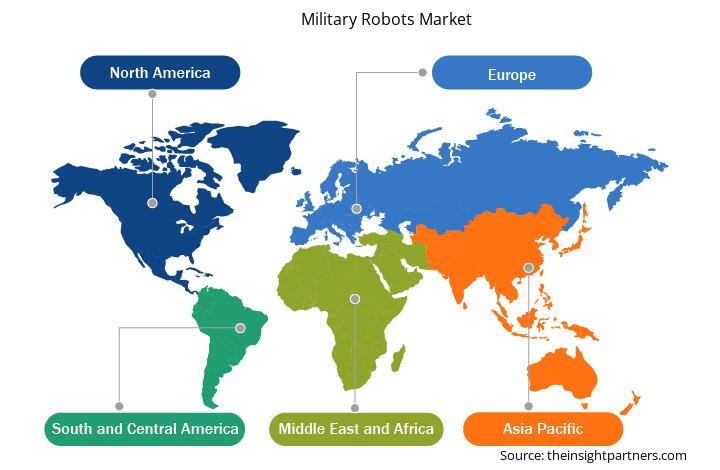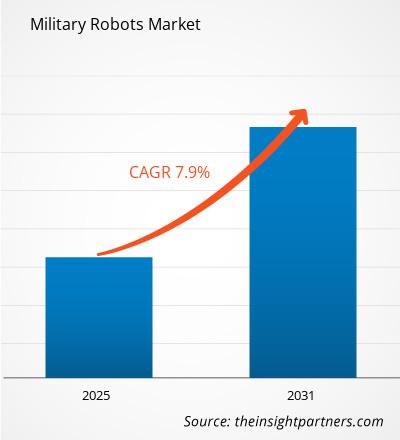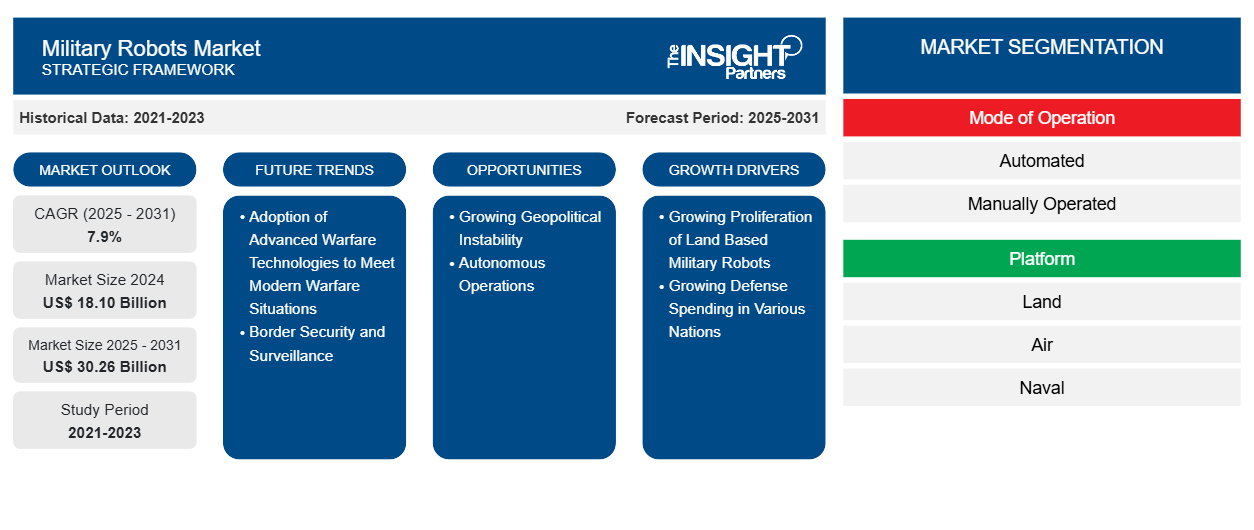军用机器人市场规模预计将从 2024 年的 181 亿美元增至 2031 年的 302.6 亿美元;预计在 2025 年至 2031 年的预测期内,复合年增长率将达到 7.9%。
报告按操作模式(自动、手动操作)、平台(陆、空、海)、应用(作战系统、ISR 、消防、炸弹/地雷探测等)进行细分。全球分析进一步细分为区域和主要国家。报告以美元为单位提供上述分析和细分的价值。
报告目的
The Insight Partners 发布的《军用机器人市场》报告旨在描述当前形势和未来增长、主要驱动因素、挑战和机遇。这将为各种业务利益相关者提供见解,例如:
- 技术提供商/制造商:了解不断变化的市场动态并了解潜在的增长机会,从而能够做出明智的战略决策。
- 投资者:对市场增长率、市场财务预测以及整个价值链中存在的机会进行全面的趋势分析。
- 监管机构:监管市场政策和警察活动,旨在最大限度地减少滥用行为,维护投资者的信任和信心,维护市场的完整性和稳定性。
军用机器人市场细分
运作方式
- 自动化
- 手动操作
平台
- 土地
- 空气
- 海军
应用
- 战斗系统
- 情报、监视与侦察
- 消防
- 炸弹/地雷探测及其他
地理
- 北美
- 欧洲
- 亚太
- 南美洲和中美洲
- 中东和非洲
定制此报告以满足您的需求
您可以免费定制任何报告,包括本报告的部分内容、国家级分析、Excel 数据包,以及为初创企业和大学提供优惠和折扣
-
获取此报告的关键市场趋势。这个免费样品将包括数据分析,从市场趋势到估计和预测。
军用机器人市场增长动力
- 陆基军用机器人的日益普及:不断变化的战争形势以及战场上日益复杂的局势和伤亡人数预计将推动全球对陆基军用机器人的需求。陆基军用机器人主要配备混合无线传感器,有助于更好地进行目标捕获、监视、搜索和救援行动。此外,陆基军用机器人利用被动红外传感器探测边境禁区内的人员存在。增加政府预算拨款,整合高端技术以加强边境安全部队,这也是全球军用机器人市场的主要推动力。
- 各国国防开支不断增长:不断变化的先进战争形势要求世界各国政府投入大量资金,向各自的国防和军事力量提供财政援助。国防预算拨款有助于军队和军事力量从国内或国际开发商那里采购先进技术、车辆和设备。政府财政援助的不断增长表明政府致力于通过军用机器人等先进设备完善国防力量。因此,陆军、海军和空军等军事和国防部队的预算拨款不断增长,预计将推动全球军用机器人市场的发展。
军用机器人市场未来趋势
- 采用先进战争技术应对现代战争形势:地缘政治局势动荡加剧,对现代战争技术的需求不断增长,推动了军用机器人市场的发展。政府加大对先进现代战争技术的投入,也是全球军用机器人市场发展的主要推动力。
- 边境安全与监视:军用机器人可用于边境控制和监视,从而能够在人员最少的情况下监控广阔区域。这些机器人可以巡逻边境、检测入侵并提供实时情报,从而在减少人力和风险的情况下增强国家安全。
军用机器人市场机会
- 地缘政治不稳定性加剧:现代战争形势要求的不断提高以及对高端作战技术的需求不断增长,成为军用机器人市场的主要驱动力。军用机器人主要是遥控或自主设备。它专为国防和军事应用而设计,例如监视、搜索和救援以及运输。当代战场上军用机器人的应用受到战争形势变化和士兵死亡人数增加的推动。士兵死亡人数的增加引发了人们的担忧,随后政府越来越关注先进的机器人设备来管理现代任务行动。陆基军用机器人的日益普及以及具有更高灵活性和安全性的多任务机器人的日益普及预计将在预测期内推动军用机器人市场的发展。
- 自主作战:军用机器人越来越多地融入自主能力,使其无需人工干预即可执行监视、侦察和爆炸物处理等任务。这些机器人依靠人工智能、机器学习和传感器融合来导航复杂环境并做出实时决策。
军用机器人市场区域洞察
Insight Partners 的分析师已详细解释了预测期内影响军用机器人市场的区域趋势和因素。本节还讨论了北美、欧洲、亚太地区、中东和非洲以及南美和中美洲的军用机器人市场细分和地理位置。

- 获取军用机器人市场的区域特定数据
军用机器人市场报告范围
| 报告属性 | 细节 |
|---|---|
| 2024 年的市场规模 | 181亿美元 |
| 2031 年市场规模 | 302.6亿美元 |
| 全球复合年增长率(2025 - 2031) | 7.9% |
| 史料 | 2021-2023 |
| 预测期 | 2025-2031 |
| 涵盖的领域 |
按运作方式
|
| 覆盖地区和国家 |
北美
|
| 市场领导者和主要公司简介 |
|
军用机器人市场参与者密度:了解其对业务动态的影响
军用机器人市场正在快速增长,这得益于终端用户需求的不断增长,而这些需求又源于消费者偏好的不断变化、技术进步以及对产品优势的认识不断提高等因素。随着需求的增加,企业正在扩大其产品范围,进行创新以满足消费者的需求,并利用新兴趋势,从而进一步推动市场增长。
市场参与者密度是指在特定市场或行业内运营的企业或公司的分布情况。它表明在给定市场空间中,相对于其规模或总市场价值,有多少竞争对手(市场参与者)存在。
在军事机器人市场运营的主要公司有:
- 英国航太系统公司
- 以色列航空工业有限公司
- 洛克希德·马丁公司
- 诺斯罗普·格鲁曼公司
- 莱茵金属股份公司
- 萨博公司
免责声明:上面列出的公司没有按照任何特定顺序排列。

- 了解军事机器人市场顶级关键参与者概况
主要卖点
- 全面覆盖:报告全面涵盖了军事机器人市场的产品、服务、类型和最终用户的分析,提供了整体概况。
- 专家分析:报告基于对行业专家和分析师的深入了解而编写。
- 最新信息:该报告涵盖了最新信息和数据趋势,确保了其与业务的相关性。
- 定制选项:此报告可以定制以满足特定客户要求并恰当地适应业务策略。
因此,军用机器人市场研究报告有助于引领解读和了解行业情景和增长前景。尽管可能存在一些合理的担忧,但本报告的总体优势往往大于劣势。
- 历史分析(2 年)、基准年、预测(7 年)及复合年增长率
- PEST和SWOT分析
- 市场规模、价值/数量 - 全球、区域、国家
- 行业和竞争格局
- Excel 数据集
近期报告
相关报告
客户评价
购买理由
- 明智的决策
- 了解市场动态
- 竞争分析
- 客户洞察
- 市场预测
- 风险规避
- 战略规划
- 投资论证
- 识别新兴市场
- 优化营销策略
- 提升运营效率
- 顺应监管趋势























 获取免费样品 - 军用机器人市场
获取免费样品 - 军用机器人市场